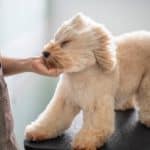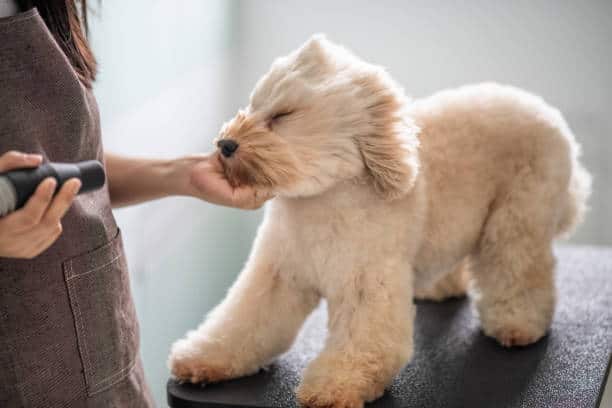Stretch drying is a method used to straighten curls and waves from the coat, leaving it as straight as possible once dried. It can create the illusion that the coat is longer than when you started. Whilst this method can be used in any circumstances where the coat needs to have the curl or wave removed, it is most often used on the feathers and furnishings of gundogs such as Spaniels, Setters and Retrievers.
In these dogs, the longer hair on the legs, ears, undercarriage and tail can be styled evenly. It is also indicated for wool coats like that of the Poodle and Bichon Frise, where the coat needs to be curl free for styling.
When hair is wet it reverts to its natural structure, so any curls or waves become apparent; if the coat is left to dry naturally, these curls and waves will tighten up and become more exaggerated.
Stretch drying is achieved by continuously brushing the hair in the direction in which it grows until it is dry. The hair then remains straight until it becomes damp, when the curls and waves will start to reappear.
This method of drying is used over the entire body, or on parts of the body, on any breed where a curl or wave in the coat prevents you from styling the coat evenly. In the case of very long silk coats like that of the Yorkshire Terrier, some Afghan Hounds, the Shih Tzu and the Lhasa Apso, the hair is stretched and then parted down the middle as soon as it is dry.
Ideally a dog’s coat needs to be styled as soon as the coat is dry, as any “resting” time will ruin your drying efforts.
Curls or waves in the coat give the impression of a shorter coat as the length of the individual hairs is taken up by the diameter of the curl. Straightening the coat therefore lengthens the individual hairs, giving a more accurate indication of the actual length of the coat. Trimming a coat that is curly will result in uneven cut lines.
You will need:
- a high-absorbency cloth;
- towels;
- a brush to suit the coat type; and
- a hair-dryer.
To achieve this method, the coat has to be brushed continuously throughout the drying time. The coat is brushed in the direction of the coat growth and you should continue brushing until the coat is absolutely dry.
Begin by towel drying the coat until it is drip dry. A blaster is not recommended on long silk coats because they are fragile and can be damaged but it is fine to use on wool coats.
towel drying the coat until it is drip dry. A blaster is not recommended on long silk coats because they are fragile and can be damaged but it is fine to use on wool coats.
A drying cage is not recommended if you want to stretch dry a coat because even minimal use will start curling a wool coat and cause shrinking or knotting in a silk coat. Using a hand or stand dryer, start by ruffling the coat with your fingers so that it is lifted off the body. This helps the skin to start to dry.
If you are stretching a silk coat, lower the dryer temperature and brush the coat continuously as it is drying with the direction of growth. These coats are fragile and generally do not carry a short undercoat that will offer the skin protection from the heat. You need to work fairly fast, taking your brush the full length of the hair.
If you are stretching a wool coat, you should again lower the dryer temperature. To stretch dry a wool coat you need to reverse your brush strokes and work against the direction of hair growth (the opposite way) so you are exposing the skin. For this you need to work even more quickly (crossing the airflow at about one brush stroke per second).
There are several advantages to stretch drying the coat:
- the individual hairs are stretched to their maximum length
- it allows the silk coat to lie sleek
- it takes the curl out of wool coats (albeit temporarily)
- and it is easier to judge length when styling and easier to cut ‘true’ trimming lines rather than cut lines that are uneven because the coat curls or waves
The disadvantage is that the groomer must work quickly so the coat is stretched before it dries. The coat will remain straight until moisture causes the hair to return to its natural texture, so you need to get the coat trimmed as soon as possible after drying.

